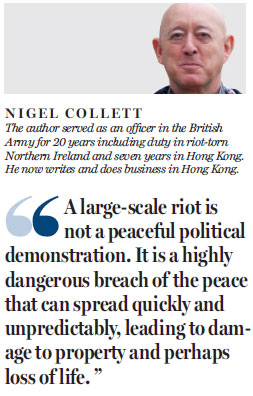Restricting police crowd control measures can lead to fatalities
Updated: 2016-02-18 08:31
By Nigel Collett(China Daily)
|
|||||||
The ramifications of "Occupy Central" continue to ripple outward. One of them was on public view during the Lunar New Year riot in Mong Kok, when the police appeared to have been unduly restricted in dispersing the crowds. It would appear that the use of tear gas during "Occupy" has led to restrictions on the use of force to deal with far more violent disturbances. In Mong Kok, police officers were reduced to using batons to beat back rioters because it seems that they were not permitted to use anything else.
Apart from the appalling PR that attaches to scenes of close-quarter beatings, the more important point is that the use of batons to control crowds leads to injuries to the public and the police.
A large-scale riot is not a peaceful political demonstration. It is a highly dangerous breach of the peace that can spread quickly and unpredictably, leading to damage to property and perhaps loss of life. The police have no option; it is their duty to restore public order by dispersing a riot. Dispersal means, in effect, making rioters run away. That has to be achieved with the minimum force, the object being to hurt as few people as possible. The best way to do that is at a distance, for close-quarter fighting inevitably leads to injury. There are basically three ways to disperse crowds at a distance without causing fatalities: water cannons; tear gas; and rubber bullets (baton rounds). These will either knock down demonstrators or make their eyes stream so badly that they cannot remain at the scene. Use of these will enable police lines to advance without having to push rioters back with shields, squirt them at close range with pepper spray or batter them with batons.
The apparent ban against the use of these non-lethal crowd control means seems to have forced the police in Mong Kok to resort to their batons. As a result, the crowds remained close enough to bombard the police with bricks and bottles. The police were unable to prevent rioters adding to the fires they had lit in the streets. Police officers forced to stand in lines were struck with bottles, stoned and needlessly injured. Individual police officers, cornered and isolated from their colleagues, were set upon.
Batons are not always effective even at close quarters. Those wielding them can be overwhelmed by longer sticks or metal bars. After that, an individual police officer is left with nothing but his sidearm. Crowds that get too close can easily overwhelm individual officers; this happened in some cases in Mong Kok. There is a very real danger that individual officers will be set upon by a mob and may lose their weapons. This time, the riot did not lead to the lethal use of firearms, but if a major riot occurs again it very well could, as a police officer in the last resort has to protect his life and that of his colleagues.
This almost happened in the first stages of the riot when the crowd attacked the 10 or so isolated traffic police officers attempting to clear a road junction. They were faced with a very hostile mob at close quarters with no riot control equipment, no protective gear and no support. One of them went down and was immediately set upon by rioters, who threw everything they could find at him, including several large rubbish containers which bounced off his body. Some of the rioters clearly aimed to do him serious bodily harm. In response, one of the policemen fired warning shots from his revolver. He was right to do so. He had a duty to save the life of his wounded colleague and there was no other way. Acting with restraint (for he could have taken aim at a live target), he hurt no one and he stopped the attack. He acted reasonably and used minimum force, and one hopes he is commended for his presence of mind and not disciplined.
These kinds of situations need to be avoided wherever possible. If all that is left to the police is the use of batons and firearms, it is only a matter of time before similar violent clashes lead to fatalities. There needs to be a graduated response to keep the crowd at a distance and disperse it using tear gas, water cannon and rubber bullets.
The safety of the public and the police is not being helped by the tactics seemingly being adopted at present. These may seem politically more acceptable but in reality they will inevitably lead to tragic results.

(China Daily 02/18/2016 page10)